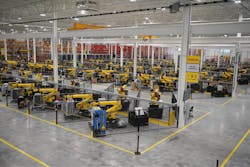So That Happened: Robotics Sales Stuck in Neutral
Editor’s note: Welcome to So That Happened, our editors’ takes on things going on in the manufacturing world that deserve some extra attention. This will appear regularly in the Member’s Only section of the site.
2024 CEO Trends
Leadership consulting firm Spencer Stuart recently released its 2024 CEO Transitions report, which tracked leadership changes in the S&P 1500 throughout last year. The report covers the Consumer, Financial Services, Healthcare, Industrial and Technology, Media and Telecom sectors. Here are some of the highlights:
- The Industrial sector had the highest percentage of incoming women CEOs at 24%
- Industrial companies also have the highest percentage of active women CEOs at 11%
- 0% of incoming CEOs in the Tech, Media and Telecom sector were women, leaving them with the lowest percentage of active women CEOs at 4%
- 60% of incoming Industrial CEOs were internal appointments.
- The Consumer and Industrial sectors had the highest CEO turnover at 12%
- “No CEO under 40 was appointed in 2024,” writes the report
- 16% are in their 40s and over half (56%) are in their 50s.
—Anna Smith
AI, EV Power Demand Equals Big Investments
From data centers needed for all of those artificial intelligence chatbots to a growing number of electric vehicles on the road, demand for electricity is growing. Despite decades of energy efficiency increases, the U.S. Energy Information Administration is projecting the first three-year increase in power demand in more than a decade.
And growth almost always means opportunity and investment for manufacturers.
- Eaton Corp. plans to spend $340 million to build a new plant for three-phase transformers in Jonesville, South Carolina
- Cummins Inc. is buying the assets of First Mode, a maker of hybrid-electric- and hybrid-hydrogen-powered mining equipment
Eaton officials say the country needs more three-phase transformers (it will continue making them in Waukesha, Wisconsin) to modernize the grid for power-hungry modern advancements. Power-hungry data centers are big part of that, but so are new manufacturing facilities that more often rely on electrical tools instead of hydraulics and pneumatics. And, DC fast chargers for EVs need the high power volumes that three-phase transformers provide as well.
“Electrical power demand is increasing dramatically, and our solutions are at the heart of energy systems everywhere, from the utility grid to industrials, data centers, buildings and more,” said Mike Yelton, president, Americas Region, Electrical Sector at Eaton.
At Cummins, Jenny Bush, president of Power Systems said many of that company’s mining equipment providers need to lower diesel use so that their mining customers can improve their emissions performances. European regulations on supplier energy use are forcing many companies to alter their basic products.
“With First Mode’s hybrid retrofit technology, we are accelerating our ability to provide decarbonization solutions that meet miners’ need to drive down operating costs today,” Bush said.
—Robert Schoenberger
ArcelorMittal Adding to Alabama Plant With $1.2B Investment
The leaders of global steel player ArcelorMittal are committing $1.2 billion to build a specialty electrical steel plant near the South Alabama plant it co-owns with Nippon Steel. The project will employ more than 200 people once it opens, which is expected to happen in 2027.
ArcelorMittal’s plan to grow its operation in Calvert aims to bolster the domestic supply of steel to be used by automotive manufacturers, particularly in electric motors, as well as companies building energy infrastructure such as wind turbines (see also above notes about Cummins and Eaton). Construction work at the site north of Mobile should start later this year.
“We’re committed to meeting the growing demand for high-quality electrical steels while helping customers overcome their supply-chain challenges,” Peter Leblanc, chief marketing officer of ArcelorMittal North America, said in a statement last week—mere days before the Trump administration said it plans to impose 25% tariffs on steel and aluminum imports.
The Calvert plan could provide a little relief to infrastructure project planners navigating today’s topsy-turvy trade policy headlines. Morningstar DBRS Senior Vice President Kevin Li said Feb. 12 that those 25% tariffs are likely to quickly disrupt supply chains for U.S. contractors working on civil or social infrastructure projects. But it’s also possible that spending already approved will take longer to materialize into actual construction.
“For projects that have not yet reached financial close, the negotiation process may be delayed as contractors will be driven to adjust the contract price or certain contractual terms to neutralize the impact of the tariffs,” Li wrote. But for projects further along in the process, “contractors may suffer painful losses during construction unless the existing contracts allow them to pass along incremental customs duties to contract counterparties in a timely fashion. Alternatively, a contractor may attempt to wait out the disruption (if deemed temporary) through the re-sequencing of construction activities, which may nevertheless cause delays.”
—Geert De Lombaerde
GE Appliances Workers Approve New Contract
In December we shared with you that union workers had roundly rejected a tentative collective bargaining agreement between GE Appliances and IUE-CWA Local 83761, which represents approximately 5,000 production workers at Appliance Park in Louisville. The contract expired at the end of 2024.
Few details were released about why the contract was rejected, but wages, healthcare and work practices had been topics of negotiation. And despite the rejection, business continued as usual as both parties agreed to return to the bargaining table in January.
A new contract is now in place. Union workers ratified the new labor agreement at the end of January, according to the Louisville Courier Journal. Moreover, they approved it as roundly as they had rejected the previous agreement, with nearly 73% of voting workers saying yes during the January vote.
Citing Local 83761 President Dino Driskell, the news outlet said the new contract represents an investment of approximately $142 million over its four-year span, and includes an approximately 60% decrease in healthcare deductibles, among other gains.
Driskell said the complete turnaround in the union vote occurred because, unlike what happened in December, the union “took more time to share and explain the contract with workers.”
— Jill Jusko
Success Can be Robots’ Worst Enemy
The Association for Advancing Automation (A3) this month released its North American robotics market report for 2024, reporting some unimpressive overall numbers, a 0.5% increase in units shipped and 0.1% increase in revenue over 2023.
The story of robotics in 2024 seems defined by expansion into non-automotive companies like food and consumer goods, that saw robot orders increase by 65%, and life sciences, pharma and biomedical companies, that as a sector increased robot orders increase by 46%.
Q4 2024 specifically showed some decent numbers over Q3 2023, with 8% growth in both units shipped and revenue for North American companies. Food and consumer goods showed 77% year-over-year growth.
In industries we more commonly associate with robotics, A3 reports losses. Orders for semiconductor and electronics companies fell by 37% annually and automotive component companies posted a 15% decline in orders.
I don’t find the results surprising. Semiconductor, electronics and automotive companies have always been ahead of the curve when it comes to robotics. Their industries might not even be possible at scale without robots, so it makes sense that without precipitous rises in the number of companies operating in these sectors, robot orders would cool.
That doesn’t mean robots are any less important or successful in these industries, it just means those companies on average excel so highly at robot deployments that they know how to use the technology to the fullest and can keep replacement unit numbers down.
—Dennis Scimeca
About the Author
Anna Smith
News Editor
News Editor
LinkedIn: https://www.linkedin.com/in/anna-m-smith/
Bio: Anna Smith joined IndustryWeek in 2021. She handles IW’s daily newsletters and breaking news of interest to the manufacturing industry. Anna was previously an editorial assistant at New Equipment Digest, Material Handling & Logistics and other publications.
Robert Schoenberger
Editor-in-Chief
LinkedIn: linkedin.com/in/robert-schoenberger-4326b810
Bio: Robert Schoenberger has been writing about manufacturing technology in one form or another since the late 1990s. He began his career in newspapers in South Texas and has worked for The Clarion-Ledger in Jackson, Mississippi; The Courier-Journal in Louisville, Kentucky; and The Plain Dealer in Cleveland where he spent more than six years as the automotive reporter. In 2014, he launched Today's Motor Vehicles (now EV Manufacturing & Design), a magazine focusing on design and manufacturing topics within the automotive and commercial truck worlds. He joined IndustryWeek in late 2021.
Geert De Lombaerde
Senior Editor
A native of Belgium, Geert De Lombaerde has been in business journalism since the mid-1990s and writes about public companies, markets and economic trends for Endeavor Business Media publications, focusing on IndustryWeek, FleetOwner, Oil & Gas Journal, T&D World and Healthcare Innovation. He also curates the twice-monthly Market Moves Strategy newsletter that showcases Endeavor stories on strategy, leadership and investment and contributes to other Market Moves newsletters.
With a degree in journalism from the University of Missouri, he began his reporting career at the Business Courier in Cincinnati in 1997, initially covering retail and the courts before shifting to banking, insurance and investing. He later was managing editor and editor of the Nashville Business Journal before being named editor of the Nashville Post in early 2008. He led a team that helped grow the Post's online traffic more than fivefold before joining Endeavor in September 2021.
Jill Jusko
Bio: Jill Jusko is executive editor for IndustryWeek. She has been writing about manufacturing operations leadership for more than 20 years. Her coverage spotlights companies that are in pursuit of world-class results in quality, productivity, cost and other benchmarks by implementing the latest continuous improvement and lean/Six-Sigma strategies. Jill also coordinates IndustryWeek’s Best Plants Awards Program, which annually salutes the leading manufacturing facilities in North America.
Have a story idea? Send it to [email protected].
Dennis Scimeca
Dennis Scimeca is a veteran technology journalist with particular experience in vision system technology, machine learning/artificial intelligence, and augmented/mixed/virtual reality (XR), with bylines in consumer, developer, and B2B outlets.
At IndustryWeek, he covers the competitive advantages gained by manufacturers that deploy proven technologies. If you would like to share your story with IndustryWeek, please contact Dennis at [email protected].




